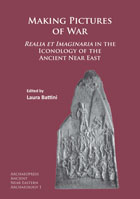Making Pictures of War : Realia et Imaginaria in the Iconology of the Ancient Near East

Battini L. (éd.) Making Pictures of War : Realia et Imaginaria in the Iconology of the Ancient Near East. Oxford : Archaeopress, 2016. 88 p.(Archaeopress Ancient Near Eastern Archaeology). ISBN : 978-1-78491-403-5.
Ce livre est la pubblication d'un colloque international sur l'iconologie de la guerre au Proche-Orient ancien qui s'est tenu à Lyon en décembre 2012. Les articles, qui s'intéressent aux images du IIIe au Ier mill. av. J.-C., tentent de répondre à plusieurs questions: qu'est ce que l'iconographie guerrière et sur quelles bases peut elle être définie? Est-ce que les scènes de guerre suivent un répertoire spécifique ? Quelle est la manière "juste" de représenter la punition des ennemis? Qui a le contrôle des images de guerre? Peut-on déterminer les conditions les plus habituelles pour la création d'images de guerre (tels que les périodes de grand changement)? Les scènes de guerre font-elles référence à des événements historiques spécifiques ou étaient-elles des représentations génériques? Qu'est-ce qu'une société peut accepter des représentations de la guerre? Qu'est-ce que les images taisent de la guerre et pourquoi? Qu'est-ce qu'une «juste» punition de l'ennemi et donc sa «juste» représentation? Qui a le contrôle de la représentation et donc aussi la mémoire de la guerre? Qui est le vrai sujet des représentations de guerre? Ce qui ressort des articles publiés ici est l'importance des données textuelles dans toute analyse de matériel iconologique. Et cela est vrai non seulement pour l'iconologie, mais pour tout le matériel archéologique découvert dans les sites historiques.
This book brings together the main discussions that took place at an international conference on the iconology of war in the ancient Near East, a subject never addressed at an international meeting before. The articles span the 3rd to the 1st millennium, with a special stress on the Neo-Assyrian period. They try to respond to many questions about representations of war: what is ‘warrior’ iconography and on what basis it can be defined? Did the war scenes follow a specific directory whereby they adopted the most varied forms? Can we determine the most usual conditions for the creation of pictures of wartime (such as periods of great change)? Were the war scenes referring to specific historical events or were they generic representations? What can a society accept from the representations of war? What did war images silence and why? What is a ‘just’ punishment for enemies and thus the ‘just’ representation of it? Who has control of the representation and therefore also the memory of war? Who is the real subject of war representations? What emerges from all the articles published here is the relevance of textual data in any analysis of iconological material. And this is not only true for iconology, but for all the archaeological material discovered at historical sites.